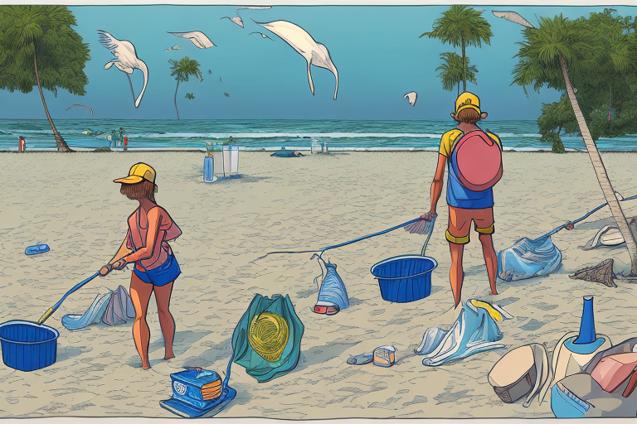
Protect the environment while sailing by participating in beach cleanups. Join or organize cleanups to help preserve ecosystems, protect marine life, and promote sustainable tourism.
How to Participate in Beach Cleanups While Sailing
Sailing the open seas with your family is an incredible adventure, but it also comes with a responsibility to protect the environment. One way to contribute to the health of our oceans and coastlines is by participating in beach cleanups. In this article, we’ll explore the importance of beach cleanups, how to find and join them, and tips for organizing your own cleanup event.
The Importance of Beach Cleanups
Beach cleanups are essential for several reasons:
-
Protecting marine life: Litter, especially plastic waste, poses a significant threat to marine life. Animals can become entangled in debris or mistake it for food, leading to injury or death. By removing trash from beaches, we can help protect these creatures and their habitats.
-
Preserving ecosystems: Beaches are home to a diverse range of plants and animals, many of which are sensitive to pollution. Cleanups help maintain the health of these ecosystems and ensure their survival for future generations.
-
Preventing pollution: Beach cleanups not only remove existing waste but also help prevent further pollution. By raising awareness about the issue and encouraging responsible behavior, we can reduce the amount of litter that ends up on our shores.
-
Promoting sustainable tourism: Clean beaches are more attractive to tourists, which can boost local economies. By participating in cleanups, we can help promote sustainable tourism and support coastal communities.
Finding Beach Cleanups
There are several ways to find beach cleanups while sailing:
-
Local organizations: Many coastal communities have organizations dedicated to protecting their environment. These groups often organize beach cleanups and other conservation efforts. Reach out to local organizations in the areas you plan to visit and ask about upcoming events.
-
Online resources: Websites like Ocean Conservancy and Surfrider Foundation maintain lists of beach cleanups around the world. Check their event calendars to find cleanups near your sailing route.
-
Social media: Follow local environmental groups and sailing communities on social media platforms like Facebook and Instagram. They often post about upcoming beach cleanups and other events.
-
Marinas and sailing clubs: Marinas and sailing clubs are great places to connect with fellow sailors and learn about local conservation efforts. Ask around to see if anyone knows of upcoming beach cleanups or is interested in organizing one.
Joining a Beach Cleanup
Once you’ve found a beach cleanup to participate in, follow these tips to ensure a successful and enjoyable experience:
-
Register in advance: Some cleanups require participants to register beforehand. This helps organizers plan for the event and ensures they have enough supplies for everyone. Be sure to sign up early to secure your spot.
-
Dress appropriately: Wear comfortable clothing that you don’t mind getting dirty, as well as sturdy shoes or sandals. Bring a hat, sunglasses, and sunscreen to protect yourself from the sun.
-
Bring supplies: Organizers typically provide trash bags and gloves, but it’s a good idea to bring your own just in case. You might also want to bring a reusable water bottle, snacks, and a small first aid kit.
-
Follow safety guidelines: Listen to the organizers’ instructions and follow any safety guidelines they provide. Be cautious when handling sharp objects or heavy items, and always wear gloves when picking up trash.
-
Sort and record your findings: Some cleanups involve sorting and recording the types of trash collected. This data can be used to track pollution trends and inform future conservation efforts. Be prepared to help with this process if needed.
-
Spread the word: Share your beach cleanup experience on social media and encourage others to get involved. The more people who participate, the greater the impact we can have on our oceans and coastlines.
Organizing Your Own Beach Cleanup
If you can’t find a beach cleanup to join, consider organizing your own. Here’s a step-by-step guide to help you get started:
-
Choose a location: Select a beach that’s accessible by boat and in need of a cleanup. Be sure to research any local regulations or restrictions before planning your event.
-
Gather supplies: You’ll need trash bags, gloves, and a way to transport the collected waste. Consider providing reusable water bottles, snacks, and sunscreen for participants.
-
Recruit volunteers: Reach out to fellow sailors, local organizations, and social media groups to recruit volunteers for your cleanup. Be sure to provide clear information about the date, time, and location of the event.
-
Promote your event: Create flyers, social media posts, and other promotional materials to spread the word about your beach cleanup. Be sure to include contact information for potential volunteers and any registration requirements.
-
Coordinate logistics: Plan how you’ll transport volunteers and supplies to the cleanup site, as well as how you’ll dispose of the collected waste. Contact local waste management facilities to inquire about proper disposal methods.
-
Host the cleanup: On the day of the event, arrive early to set up and greet volunteers. Provide a brief orientation, including safety guidelines and instructions for sorting and recording trash. After the cleanup, thank your volunteers and share the results of your efforts on social media.
Conclusion
Participating in beach cleanups is a rewarding way to give back to the environment while enjoying your sailing adventure. By joining or organizing cleanups, you can help protect marine life, preserve ecosystems, and promote sustainable tourism. So, as you set sail with your family, consider making beach cleanups a regular part of your journey. Together, we can make a difference for our oceans and coastlines.